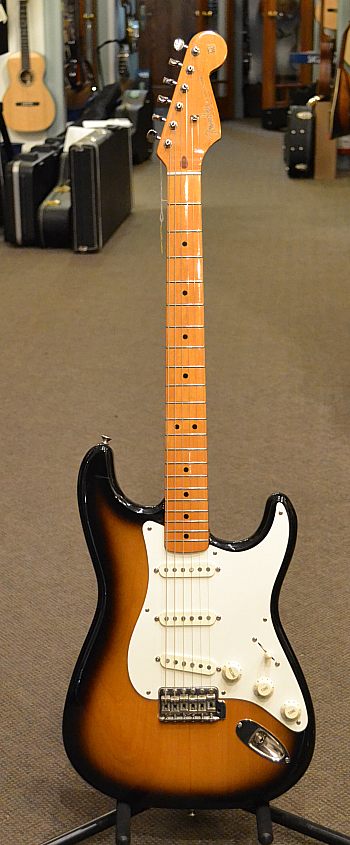

The old Fender amps were not very consistent in sound, due to the fact that the factory tended to use whatever components they had on hand at the time, often of loose tolerance, which led to variations in circuit voltages that could affect sound. The new circuit is geared toward a brighter, louder sound, with the flexibility of being able to adjust bias on output tubes to provide a more customized sound and allow changes of output tubes from one brand to another.Ī few design considerations are in order for us “filament brains” and non-tech types as well. There are also a couple of internal fuses on the new circuit (good idea). There is no bias adjustment pot on the original, and output tube plate voltages have been increased in the reissue to 450V from original 400V. The original used three 12AY7 preamp tubes (but the same AX as the phase inverter). There are separate Bright and Normal channels, each with its own preamp circuit, separate Volume controls and two jacks, followed by Treble, Bass, and Presence controls that are common to both channels.Ĭomparing schematics of old and new, there are some relatively important differences. The top rear-positioned control panel features five chicken-head knobs, which all traverse from 1–12 (take that, Nigel). The speakers are 12” Eminence Alnicos designed by Ted Weber (of Weber VST), which look remarkably like Weber P-12Ns. The tube complement includes four Sovtek 12AX7WCs, relabeled Groove Tubes 12AX7- R two Groove Tubes-6L6GE (made in the USA) and two Electro Harmonix 5U4GB rectifiers. There is a bias adjustment pot on the circuit board. The switches, jacks and pots are high quality and the transformers and choke are from the highly regarded Mercury Magnetics Company. The chromed steel vertical chassis houses highquality components mounted on a sturdy black fiberglass eyelet board, sturdy tube sockets, and nicely done point-to-point wiring.

The nicely applied lacquered Tweed cloth covers a finger-jointed, solid-pine cabinet with a thin leather handle (more on that later). The ’57 Twin RI is a replica of its predecessor manufactured by the Fender Custom Shop (with a few changes thrown in for versatility’s sake).

The subsequent Twin Amp models featured four output tubes and high-power or solid-state rectifiers and many more output watts, making them suitable only for very loud rock gigs and large venues. This made the Twin loud and punchy enough to cut through, but also allowed another browner, spongy tone favored mainly by Blues players by simply removing one of the rectifiers. What is unique about the 5E8-A is that it used two 5U4 rectifier tubes (higher power rectifiers had not been invented yet) to prevent the sag of the attack/decay envelope and allow a decrease in the negative feedback loop to the tone stack. As the models changed, the power output increased. The Twin underwent constant modification and several model changes in the years to follow. Beginning in 1952 at 25 watts, the Twin Amp was Leo’s answer to this demand. They needed to fill the sonic space of large ballrooms, dance halls, roadhouses and outdoor celebrations without the benefit of the Front of House monoliths that are seen at today’s large venues. Most of his advisers were the country guitar and steel players of southern California, with a few big-city rock ‘n’ rollers thrown in. Leo Fender could not play the guitar, but he had a knack for translating into products the suggestions and demands of those who could. The early circuits based on these primitive tubes were simple, and the initial amp models were wimpy, but somewhere against the hum of these primordial beasts the sharp report of the starter’s pistol signaled the beginning of the amplifier race. The first Fender amps (and most others) were born out of circuits printed in the back pages of tube manufacturers’ catalogs suggesting ways to use their new audio tubes.
FENDER 57 BANDMASTER REISSUE REVIEW SERIES
Most contemporary players understood the choice of the first series of reissue models, but sometime around 2004 the ’57 Twin (model 5E8-A, also known as the low-power Twin) came out, and the less vintage-oriented players scratched their gearheads and wondered. It didn’t take Fender long to figure out that there was a market waiting for reissues of some of their most revered models, and thus followed a steady stream of amps that bore the Fender logo and looked just like the amps of yore. I invested in a Clark Piedmont (’59 Bassman) and a Clark Beaufort (narrow panel Deluxe) and so am well acquainted with the high standards used to produce these replicas.
FENDER 57 BANDMASTER REISSUE REVIEW ZIP FILE
Download Examples 3.9MB Zip file with 10 mp3s and descriptionĪ couple of decades ago several small amp manufacturers, noting the demand for used Fender amps, started to produce amplifiers using old Fender circuits, capitalizing on the simplicity of operation and purity of tone of these classics.


 0 kommentar(er)
0 kommentar(er)
